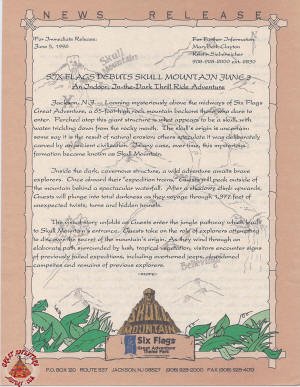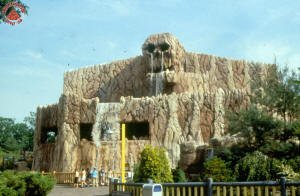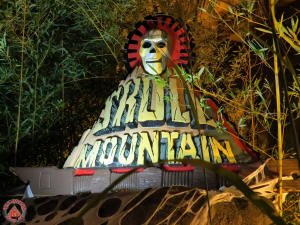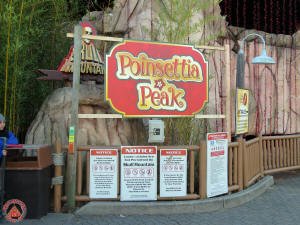
Under the ownership of Time Warner, theming became a focal point of
roller coasters and other attractions in the Six Flags chain. Enhanced
theming throughout queue lines and on rides themselves can elevate the
experiences of guests and immerse them in the world of the attraction.
Like the other Great Adventure additions of the 1990’s, Skull Mountain
was no exception in providing an entrancing experience that went beyond
the coaster itself.
|
|
|

|
| |
|
|
| |
|
|
 |
 |
 |
| |
|
|

 |
In the early-mid 90’s computers weren’t capable of producing digital
models to the level commonly seen today. Through detailed concept art
and blueprints, a physical, scale model was made to show an early
rendering of Skull Mountain. The front facade and its size were shown
relative to the average height of guests.
Click on the Scale Model icon for more info! |
| |
|
|
 |
 |
 |
| |
|
|
| |
|
|
| |
|
|
 |
 |
 |
| |
|
|

 |
Not only did crews work diligently to install the coaster itself, but
they also had an entire building and faux mountain to build.
Construction involved the removal and relocation of the Rotor ride and
lots of land-clearing before the coaster could begin to take shape.
Click on the Construction icon for more info! |
| |
|
|
 |
 |
 |
| |
|
|
| |
|
|
| |
|
|
 |
 |
 |
| |
|
|

 |
Before the addition of Jolly Roger in 1999, Skull Mountain’s queue line
extended past the built-in caverns at its base. Winding walkways had
guests pass by artifacts which tied into the story of a failed
exploration of the mountain. Some of these props even continue to be
used today for other events and attractions!
Click on the Original Queue icon for more info! |
| |
|
|
 |
 |
 |
| |
|
|
| |
|
|
| |
|
|
|
The press release for Skull Mountain marketed the ride as more than a
run-of-the-mill coaster. This new coaster would be a fully-themed
entertainment experience where guests would attempt to safely explore
the ominous and foreboding Skull Mountain. The emphasis here would be
overall entertainment and to give a greater impression beyond the
experience of riding a roller coaster. |
 |
 |
| |
|
|
 |
 |
 |
| |
|
|
| |
|
|
 |
 |
| |
|
|
|
Even the opening ceremony brought great attention to the fact that Skull
Mountain was an ambitious coaster for Six Flags, with emphasis on
fantasy and experience. As a tie-in with the new Lethal Weapon Stunt
Show, “Leo Goetz” made a special appearance with Park President Vince
Lupinacci to set off the fireworks and help welcome guests to the
coaster on opening day- June 3, 1996. |
| |
|
|
 |
 |
 |
| |
|
|
 |
Prior to 1996, no type of coaster like Skull Mountain had existed at
Great Adventure. With an elaborate queue line and a dramatic back story,
this new family coaster would lay heavily into a themed atmosphere and
be a standout attraction among its more primarily thrill-based
counterparts. |
 |
| |
 |
| |
|
|
 |
 |
 |
| |
|
|
 |
 |
 |
| |
|
|
 |
 |
 |
| |
|
|
 |
As the press release had described, the story of Skull Mountain had
riders exploring an ominous mountain which many other explorers had
previously failed to do. Guests navigated bamboo paths, waterfalls,
lantern-light tunnels and caves to make their way to the station and
their expedition vehicle! |
 |
| |
|
|
 |
 |
 |
|
|
|
|
 |
 |
 |
|
|
|
|
 |
 |
 |
| |
|
|
 |
 |
 |
| |
|
|
 |
 |
 |
| |
|
|
 |
 |
| |
|
|
 |
 |
 |
| |
|
 |
 |
| |
|
|
 |
 |
 |
| |
 |
| |
|
|
 |
 |
 |
| |
|
|
 |
 |
 |
| |
|
|
 |
 |
| |
|
|
 |
Originally a solid orange, later the trains were meant to look as if
they had a rock-like texture - as if they had been boulders traversing
the mountain. Employee areas and maintenance rooms were meant to look as
if they were abandoned mine shafts. They barred off guests from entry
under the guise that they were “condemned” areas of the mountain. |
 |
| |
 |
| |
|
|
 |
 |
 |
| |
|
|
 |
 |
 |
| |
|
|
 |
 |
 |
|
|
|
|
 |
The ride itself was an upscale family coaster with a mix of thrilling
elements. Although it can’t be seen without the lights on, there are
plenty of near-miss effects and tight turns. The little bit of light
came from black-lit props and strobe lights, all to the soundtrack of
pulsating heavy metal music. |
 |
| |
 |
| |
|
|
 |
 |
 |
| |
|
|
 |
 |
 |
| |
|
|
 |
 |
 |
|
|
|
Over time, the original entrance sign became weathered from sunlight and
its colors faded. The sign would be repainted and its colors brightened.
After restoration of the entrance sign, additional tribal art was added
along the rock work, along with a warning to guests that the ride would
use strobe lights. |
|
|
|
|
 |
 |
 |
| |
|
 |
 |
| |
|
|
 |
 |
 |
| |
|
|
 |
 |
 |
| |
 |
| |
|
|
 |
At the time of its opening, Skull Mountain looked just like a real
mountain. With faux rocks that blended into painted facades on its
building, the ride was given the illusion of depth. Unfortunately, the
rocks have chipped away and the paint has faded without restoration. In
some spots more than others, the wearing down of the rocks was
especially evident. Oftentimes too the waterfall flowing from the skull
topper would be off - sometimes because of employee forgetfulness to
turn it on, other times in an effort by the park to reduce energy costs.
For a time, the fountain received extended downtime. |
 |
| |
|
|
| |
|
|
 |
 |
 |
| |
|
|
 |
In recent years, Skull Mountain has been sponsored by Takis rolled
tortilla chips. Banners were placed in the queue and station, sometimes
distracting from the dark color pallet of the coaster with their own
vibrant purples, reds and yellows. Takis signage dared riders to embark
on a journey within the mountain, which was akin to the “extreme flavor”
of the snack. |
 |
| |
|
 |
 |
|
|
|
 |
 |
| |
|
|
 |
 |
 |
| |
|
|
 |
After years of being dry, the fountain was seemingly back for good
starting in the 2015 season. The water flowed down into a pool on an
upper level after starting in the skull’s eyes, which then trickled down
to a second pool at ground level, sometimes misting guests in the queue
line when they were near the path of the stream. This fountain was
complemented by an old Adventure Rivers rock-work fountain across the
way, which has outlived the section to which it once belonged. |
 |
| |
|
|
| |
|
|
 |
 |
 |
| |
|
|
 |
 |
 |
| |
|
|
 |
 |
 |
| |
|
|
 |
Starting in 2015, Great Adventure introduced “Holiday in the Park”, a
seasonal event which would see select rides open during the holiday
season. To fit the Christmas theme, Skull Mountain was renamed
Poinsettia Peak for the event. Special brackets were fitted onto the
structure for drapes of red lights to line the mountain. |
 |
| |
|
 |
 |
| |
|
|
 |
 |
 |
| |
|
|
 |
 |
 |
| |
|
|
 |
The lighting brackets would cover the skull and run down the sides of
the mountain in order to achieve a pure red look. A new Poinsettia Peak
sign was placed over the existing sign for the winter months. The
surrounding area’s trees also received red lighting, and a tree made of
poinsettias was placed in the nearby plaza. |
 |
| |
|
|
 |
 |
 |
|
|
|
|
 |
As expected, the transition to turn Skull Mountain into Poinsettia Peak
was very labor intensive. So starting in the 2018 season, red flood
lights replaced the brackets of strand lighting. This gave the mountain
a more smooth appearance rather than as a mass of vertical red lines.
The strands would later be reused for the holiday display near the
Frontier Adventures Sky Way station starting in 2019 and in the walkway
leading up to the Jolly Jamboree section in 2020. |
 |
|
|
|
 |
 |
|
|
|
|
 |
 |
 |
|
|
|
|
 |
 |
 |
|
|
|
|
| |
|
|
|
|
|
|
 |
 |
 |
|
|
|
|
 |
 |
 |
| |
|
|
 |
 |
 |
| |
|
|
 |
In 2016, Virtual Reality on roller coasters was a trend that Six Flags
was experimenting with chain wide. For Fright Fest that year, Skull
Mountain would receive its own VR experience called “Rage of the
Gargoyles”. Using Samsung headsets while riding, guests were given the
experience of a city overrun by Gargoyles and tasked to help defeat
them! The VR often proved problematic however, with frequent downtime
for cleaning of the headsets and technical difficulties. After its
trial run in the fall of 2016, the VR experience never returned to the
Skull Mountain although it would be used briefly on the Zumanjaro Drop
of Doom ride in 2017. |
 |
| |
|
|
 |
| |
|
|
 |
 |
 |
| |
|
 |
 |
|
|
|
|
| |
|
|
| |
|
|
 |

SOUVENIRS |
| |
|
|
 |
 |
 |
| |
|
 |
 |
| |
|
|
| |
|
|
|
Original Spotlight: July 19, 2007, Update: February 28, 2021. GAH Reference #: RIDE-1996-001 |
| |
|
|
 |
| |
|
|
 |
 |
 |
|
|
|
|

UPDATE COMING SOON! |
 |
 |



